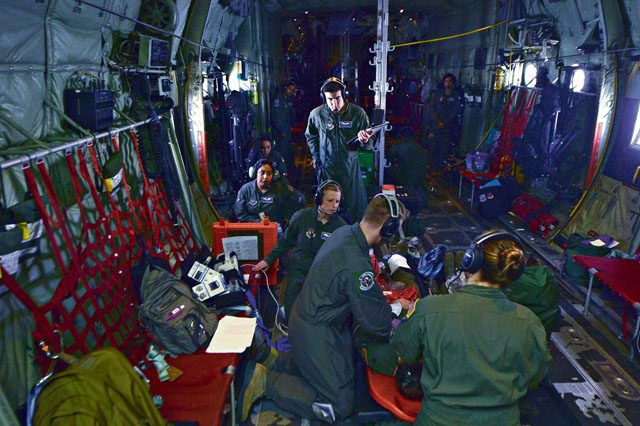
The roaring engines of a C-130J Super Hercules nearly drown out the Airman’s commands as the team quickly, yet systematically load medical supplies and simulated patients through the aircraft’s open ramp in preparation for a flight departing Ramstein.
The 86th Aeromedical Evacuation Squadron flight nurses and aeromedical evacuation technicians practice like they fight.
The Airmen conduct training scenarios called aeromedical readiness missions in order to better prepare themselves for possible future scenarios. Their mission is to provide time-sensitive, mission-critical en route care to patients going to and between medical treatment facilities.
Their patients include veterans and their dependents injured across Europe, Africa and in deployed locations.
Capt. Jeana Angulo, 86 AES, has been a flight nurse for more than a year and said it’s been an interesting roller coaster ride and a huge change from the hospital environment.
“You have to be a competent clinician first to be able to feel confident to go up into the air at (a high) altitude and take care of a patient,” Angulo said. “At the same time, you do have to know your capabilities, and if the worst-case scenario happens, (you need to) have it under control. It is tough.”
Capabilities such as operating equipment and sustaining resources is significant in caring for their patients’ lives and their own.
With the aircraft’s continuous engine noise, compact space and limited medications and equipment, assisting patients in a mobile clinic offers its own challenges.
“We had a lot more resources available to us,” said Staff Sgt. Christine Holmes, 86 AES aeromedical evacuation technician, about her previous work in a clinic. “We had everything we needed for a patient, but when you’re in the air, you’re part of a five-man crew of nurses and technicians. If a patient goes south or (is) having some problems in-flight, you have to think outside the box. Seeing the injuries we see and having to adjust your thinking to those situations is challenging sometimes, but definitely rewarding.”
On top of the conditions and injuries, the aeromedical evacuation crew must utilize critical thinking skills to care for patients whose symptoms change in-flight.
“Once you bring them up to (a certain) altitude you have factors to consider,” Angulo said, “Decrease partial pressure or oxygen, barometric pressure changes, humidity factors and fatigue from flying (are a few considerations). All those factors we have to learn, the stresses of flight and how they specifically affect those diagnoses.”
In addition, the crew must learn the aircraft and its emergency procedures. The 86 AES members are qualified on the KC-135 Stratotanker, C-130J Super Hercules, C-17 Globemaster III and C-21.
The crew is trained on understanding the aircraft’s emergency procedures and electrical capabilities.
“We have to learn so much about the aircraft and how to take care of our patients, as well as ourselves, in the event of the emergency,” Angulo said.
One of the resources Airmen must monitor is calculating the transformer’s amps to utilize equipment for patients and emergencies.
“We have to watch how many amps we’re pulling and how many the aircraft can give,” Angulo said. “We have to take into consideration how much oxygen that big green box can hold and (if we have enough). A lot of factors play (into our actions).”
Thus, the weekly ARMs help 86 AES Airmen stay updated on their duties. The training missions provide the crew with simulated patient treatment plans and the opportunity to act and talk out their protocol in real time. After mock patient treatments, flight nurses act as instructors and quiz the crew on further care plans.
Senior Airman Cristhian Rodriguez, 86 AES aeromedical evacuation technician, said because each patient has their own treatment plan, he’s continually learning.
“It’s a fast-paced job,” Rodriquez said. “It’s something different every time we fly — different aircraft, environment and place.”
The crew follows an extensive checklist in which they’re responsible for knowing the expanded protocols on events such as emergency landing, rapid decompression and fire in-flight.
“(The checklist) touches on these responsibilities and gives us guidance on how we’re supposed to react,” Angulo said. “As we are not doctors, we have to rely on our protocols. It’s important to maintain a checklist.”
Though the crew has many responsibilities, the mission can be rewarding.
“I think it’s special to be part of this mission,” Rodriguez said. “We pick up patients who have been all over the world, and we get to hear their experiences. I’ve always loved patient care, and I like to serve others. I think this is the best job ever. Even if it was a long flight, at the end of the day you feel a great sense of accomplishment.”
Whether they are hastily loading supplies or aiding a mock patient approximately 30,000 feet in the air, the 86 AES continues to practice procedures in an effort to provide the best care that they can.


